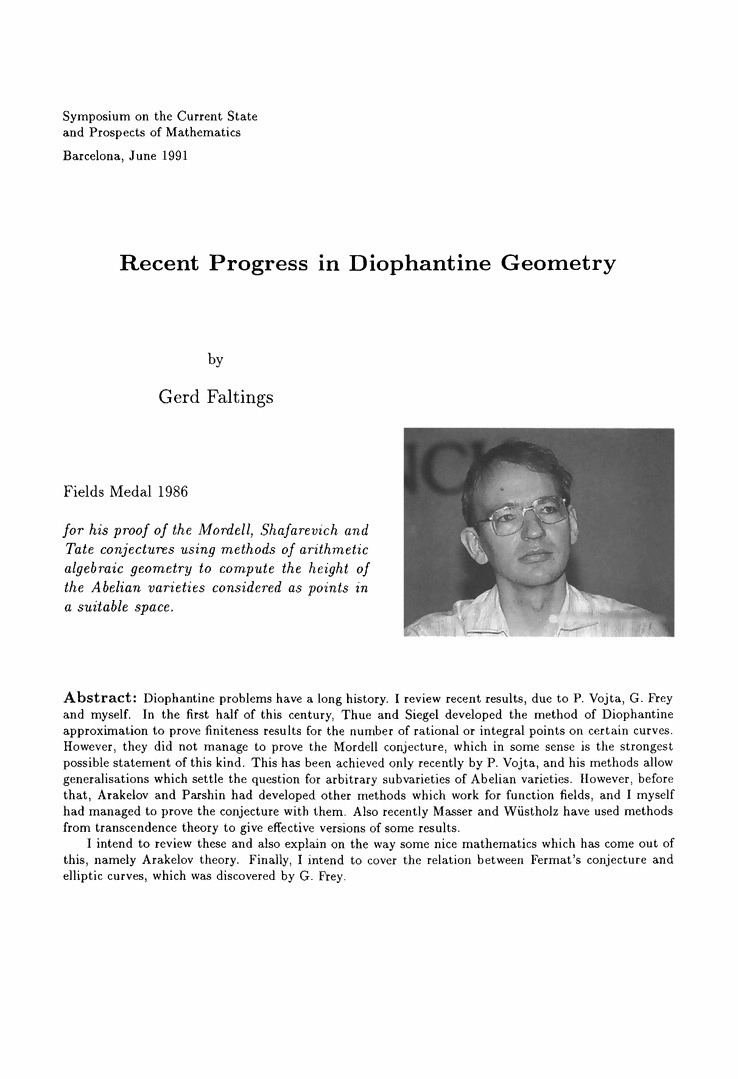 | ||
What is the mordell lang problem
In mathematics, diophantine geometry is one approach to the theory of Diophantine equations, formulating questions about such equations in terms of algebraic geometry over a ground field K that is not algebraically closed, such as the field of rational numbers or a finite field, or more general commutative ring such as the integers. A single equation defines a hypersurface, and simultaneous Diophantine equations give rise to a general algebraic variety V over K; the typical question is about the nature of the set V(K) of points on V with co-ordinates in K, and by means of height functions quantitative questions about the "size" of these solutions may be posed, as well as the qualitative issues of whether any points exist, and if so whether there are an infinite number. Given the geometric approach, the consideration of homogeneous equations and homogeneous co-ordinates is fundamental, for the same reasons that projective geometry is the dominant approach in algebraic geometry. Rational number solutions therefore are the primary consideration; but integral solutions (i.e. lattice points) can be treated in the same way as an affine variety may be considered inside a projective variety that has extra points at infinity.
Contents
- What is the mordell lang problem
- Motivic fundamental groups and diophantine geometry i
- Background
- References
The general approach of diophantine geometry is illustrated by Faltings' theorem (a conjecture of L. J. Mordell) stating that an algebraic curve C of genus g > 1 over the rational numbers has only finitely many rational points. The first result of this kind may have been the theorem of Hilbert and Hurwitz dealing with the case g = 0. The theory consists both of theorems and many conjectures and open questions.
Motivic fundamental groups and diophantine geometry i
Background
Serge Lang published a book Diophantine Geometry in the area, in 1962. The traditional arrangement of material on Diophantine equations was by degree and number of variables, as in Mordell's Diophantine Equations (1969). Mordell's book starts with a remark on homogeneous equations f = 0 over the rational field, attributed to C. F. Gauss, that non-zero solutions in integers (even primitive lattice points) exist if non-zero rational solutions do, and notes a caveat of L. E. Dickson, which is about parametric solutions. The Hilbert–Hurwitz result from 1890 reducing the diophantine geometry of curves of genus 0 to degrees 1 and 2 (conic sections) occurs in Chapter 17, as does Mordell's conjecture. Siegel's theorem on integral points occurs in Chapter 28. Mordell's theorem on the finite generation of the group of rational points on an elliptic curve is in Chapter 16, and integer points on the Mordell curve in Chapter 26.
In a hostile review of Lang's book, Mordell wrote
He notes that the content of the book is largely versions of the Mordell–Weil theorem, Thue–Siegel–Roth theorem, Siegel's theorem, with a treatment of Hilbert's irreducibility theorem and applications (in the style of Siegel). Leaving aside issues of generality, and a completely different style, the major mathematical difference between the two books is that Lang used abelian varieties and offered a proof of Siegel's theorem, while Mordell noted that the proof "is of a very advanced character" (p. 263).
Despite a bad press initially, Lang's conception has been sufficiently widely accepted for a 2006 tribute to call the book "visionary". A larger field sometimes called "arithmetic of algebraic varieties" now includes diophantine geometry with class field theory, complex multiplication, local zeta-functions and L-functions. Paul Vojta wrote:
While others at the time shared this viewpoint (e.g., Weil, Tate, Serre), it is easy to forget that others did not, as Mordell's review of Diophantine Geometry attests.